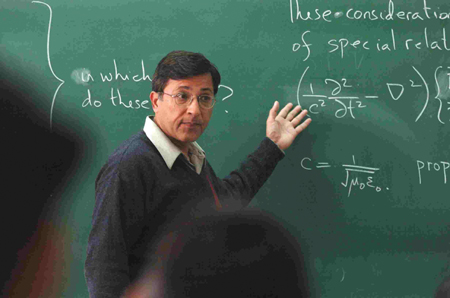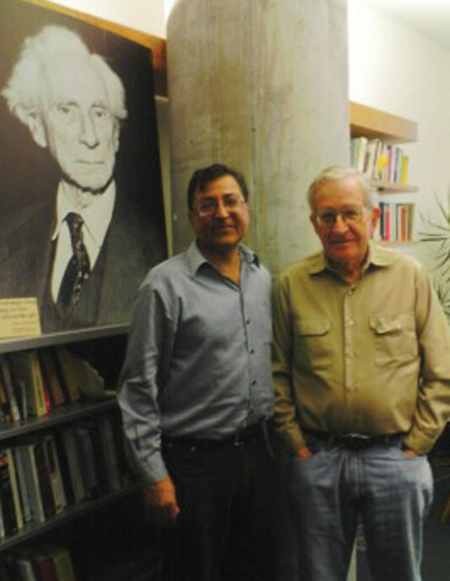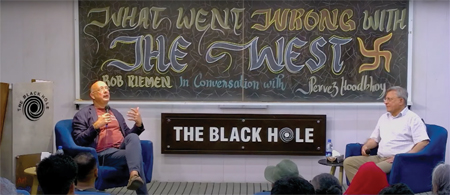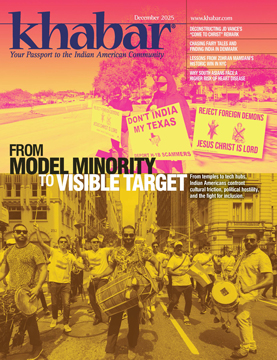Interview: Pakistan’s Voice of Reason

Nuclear physicist DR. PERVEZ HOODBHOY has been a tireless champion of nuclear nonproliferation, Indo-Pak peace, secularism, and rational, science-based education—in a nation where such progressive views are often met with hostility. In our exclusive interview, Hoodbhoy talks about quantum physics, The Black Hole (his latest initiative), the recent military clashes between India and Pakistan, the false promise of nuclear armament, and more.
I suspect that the subject of this article, Dr. Hoodbhoy himself, might not be too thrilled with the title of this article. To identify him as “Pakistan’s voice” goes against what he has tirelessly championed for decades: the futility of identities that are ideologically tied to a religion or a nation. As someone who sees himself as a citizen of the world and who recognizes the ephemeral nature of national borders, he might prefer to be described as a “global” voice of reason. Let him, and readers, be assured that the use of “Pakistan” in the title is only to contextualize his birth and residency in that land, nothing more.
Through a decades-long career in nuclear physics and public engagement, Dr. Pervez Amirali Hoodbhoy has risen to become one of South Asia’s most important voices for scientific rationality, nuclear disarmament, and peace between India and Pakistan.
 [Right] Dr. Hoodbhoy taught at the Islamabad University for nearly five decades, inspiring generations of students in physics, mathematics, and even sociology.
[Right] Dr. Hoodbhoy taught at the Islamabad University for nearly five decades, inspiring generations of students in physics, mathematics, and even sociology.
This formidable figure in Pakistan’s intellectual landscape was born in Karachi on July 11, 1950, into a Sindhi Ismaili family. Hoodbhoy’s upbringing was shaped by his father’s skepticism toward religious orthodoxy, fostering in young Pervez a questioning spirit that later defined his career. His fascination with science began early, tinkering with gadgets and machinery, which led him to the Massachusetts Institute of Technology (MIT) on a partial scholarship. To support himself, he worked various campus jobs—cafeteria staff, library assistant, and even janitor. He credits these experiences with teaching him the dignity of labor and humility.
At MIT, Hoodbhoy earned bachelor’s and master’s degrees in mathematics, electrical engineering, solid-state physics, and a PhD in nuclear physics. He returned to Pakistan in 1973 and joined Quaid-e-Azam University (then Islamabad University), where he taught for nearly five decades, inspiring generations of students in physics, mathematics, and even sociology.
While Hoodbhoy’s scientific credentials are impeccable, his true claim to fame lies in his activism as a tireless advocate for nuclear disarmament, often at great personal risk. In a region where nuclear weapons are seen as symbols of national pride, Hoodbhoy’s outspoken opposition to the arms race between India and Pakistan has made him both revered and reviled. One of his most significant contributions is his book, Confronting the Bomb (Oxford University Press, 2013), in which he brings together voices from both sides of the border, advocating for peace and rational discourse over militaristic posturing.
Hoodbhoy is a passionate advocate for secularism and freedom of speech, and for promoting a scientific mindset in Pakistan’s education system. As chairman of the nonprofit Mashal Books in Lahore, he has led initiatives to translate books on modern thought, human rights, and women’s emancipation into Urdu, making them accessible to a wider audience.
He describes himself as a “global citizen,” committed to universal values rather than parochial loyalties. Despite facing accusations of “treason” and “unbelief” from Pakistan’s conservative quarters, Hoodbhoy remains undeterred. There have also been well-deserved accolades. The Daily Times of Pakistan called him “one of our national heroes.”
The following are excerpts from our interview with Dr. Hoodbhoy while he was in Atlanta in May for a fundraiser for The Black Hole, his initiative described as “a community space for science, art, and culture.”
The concept of Maya—that the world and creation are ultimately illusory—is a key tenet of ancient yogic teachings. The Bhagavad Gita, too, refers to the formless essence of everything, including people.
Interestingly, modern quantum physics seems to be heading in the same direction. The discovery of ever-smaller particles of matter, such as quarks and leptons, along with the theory of relativity, string theory, and the wave-particle theory—all seem to point towards a mystical formless essence as the substratum of all matter. As a professional nuclear physicist, what are your thoughts about it?
No physicist will deny that there are many mysteries in quantum mechanics, but 99 percent of those who study it do so because it leads to tangible, testable, and very useful results. These have led us to the deepest understanding of nature, such as what is inside the atom and what atoms can do when they join together and make molecules, which then make bigger molecules, which then make proteins, ultimately leading to cells and to life itself.
 There are things that we do not fully understand about quantum mechanics, the nature of measurement being central to that. But my interest is in its application, and so I’ll leave these esoteric matters for bigger brains than mine to figure out. Just between us, I think quantum mechanics has been over-mystified. As a tool for probing the nature of matter and manipulating it for human needs, quantum mechanics has achieved enormous progress. The modern material civilization owes its existence to our ability to make electrons dance as we want them to. In my opinion, no religion or set of supernatural beliefs has made even the slightest contribution to our understanding of nature.
There are things that we do not fully understand about quantum mechanics, the nature of measurement being central to that. But my interest is in its application, and so I’ll leave these esoteric matters for bigger brains than mine to figure out. Just between us, I think quantum mechanics has been over-mystified. As a tool for probing the nature of matter and manipulating it for human needs, quantum mechanics has achieved enormous progress. The modern material civilization owes its existence to our ability to make electrons dance as we want them to. In my opinion, no religion or set of supernatural beliefs has made even the slightest contribution to our understanding of nature.
[Left] With his mentor and friend, Noam Chomsky, the American intellectual giant.
You have been a prominent critic of Pakistan’s public education system, stating that its emphasis on rote learning, often influenced by religious ideology, fails to foster curiosity and independent thinking. How, then, do you account for your remarkable thirst for knowledge? Are you an outlier in Pakistan’s education system?
Yes, I’m an outlier, and there are many other outliers too. But such people are always in the minority. The bulk of our population has been denied access to the kind of education that is common in the rest of the world. In Pakistan, an excess of Islamic education emphasizes rote memorization from a very early age. This reliance on memorization then extends to learning secular subjects such as physics, chemistry, and math, and that diminishes the ability to think critically. Unfortunately for Pakistan, tradition continues to overshadow the demands of modernity in more ways than one.
Your initiative, The Black Hole (TBH), is commendable for cultivating a thinking mind. Do you believe such initiatives can eventually find a place in the institutional curriculum of primary education throughout Pakistan? Or do you fear they will remain an extracurricular activity for a few lucky ones?
This is a tiny project to change the culture and the society. Many such individual initiatives are needed to bring about substantial changes. I don’t want to exaggerate the importance of TBH, but it can be an example for others. Because we live in the age of the internet and social media, we get millions of online views. And so, in that sense, I think it’s worthy of some attention, and one hopes that there will be not one TBH, but many all across Pakistan.
I want to say how unusual this idea is. Communities in Muslim countries generally center around the mosque. The Black Hole, on the other hand, is a secular space. We invite those who are interested in science, history, environment, or anything else under the sun that’s interesting and worthy of discussion. If there are speakers who have some recognizable competence in what they choose to speak on, then they are welcome. We have had many sessions on India-Pakistan and Israel-Iran [relations].
You have said that a nation that prioritizes science, technology, and development has the chance of defeating religious fundamentalism and parochialism. But look at the U.S., which has been a world leader in science and technology, and yet today it has suddenly turned nastily nativist. Why do you think that is so?
Humanity has two big enemies—religious fanaticism and extreme nationalism. Extreme nationalism led to the Second World War, which left Europe in ruins. So also for Japan. These twin evils can work hand in hand, as in today’s Pakistan. One now sees pretty much the same in India. Xenophobia is on the upswing elsewhere in the world as well. The “Make America Great Again” movement in the United States couples perfectly with the fundamentalism of the Bible Belt!

[Right] “Stop killing the Baloch—they are our Pakistani brothers. We are protesting peacefully,” says Hoodbhoy to a Pakistani soldier.
Why do you think India took a turn towards hardline Hindutva in recent decades, despite Hinduism being such a syncretic religion in its essence?
The rise of Hindutva came from, I think, the failure of secular nationalism, which also brought with it a nominally secular government, the Congress, but which was inefficient and corrupt, and gave space to those prone to nationalism and religion. Where secular nationalist governments fail, the vacuum is then filled by extreme religious forces. We saw that in Palestine—when the PLO became a corrupt force, it surrendered its ideals. The result was that Hamas took over. In India, the BJP took over, with its dream of a Hindu Rashtra. Latent in all of us is the desire to follow the crowd, and crowds are most easily summoned when things are simplified, such as when you can blame one external actor for all the evils in society.
How do you respond to those who argue that nuclear weapons are necessary for nations to protect themselves? Many people point to Ukraine, saying that it would have had a stronger position to negotiate if it had not dismantled its nuclear arsenal.
I would argue the opposite. If India had not tested nuclear weapons in 1974, Pakistan would not have started its program. And in that case, it would have been impossible for Pakistan to have harbored terrorists on its soil, because India would have attacked and wiped them out. Kargil would never have happened. I would contend that Kargil is the first war in history that was caused because of nuclear weapons. Pakistan breached the LOC in Kargil only because it believed in a protective nuclear cover. I think the absence of nuclear weapons would have led to a calmer relationship between the two. Perhaps we would be trading with each other [and] having tourists go over to each other’s sides.

[Left] Hoodbhoy (seated) discussing “Pahalgam’s Aftermath” in a live virtual conversation with Siddharth Varadarajan, veteran journalist and one of the founding editors of The Wire.
In a theocracy like Pakistan, do you feel that nonbelievers like you feel restricted in any way? For example, would your patriotism be automatically considered suspect? Would it limit the possibilities for you to hold an important national office?
Well, certainly I’m not very popular with the establishment and all those who subscribe to Pakistan’s national narrative. Indeed, I would not be allowed to hold any top position in government, and I have been dismissed twice from my university positions because of my views. But on the other hand, I have never experienced physical violence, and I believe that it is possible to remain a critic without being targeted. Also, I’ve had luck on my side.
So, even in an academic environment, fidelity to religion is expected?
Very much so. If you don’t go for Friday prayers or fast, you are automatically put in a different class. That’s why people want to wear religion on their sleeve as a means of progressing on their career ladder. Where I live, which is in the heart of the Punjab and close to the governing centers, it is even more so. Religious beliefs are particularly rigid here. But away from the core, you will find a softer Pakistan.
What are your takeaways regarding the latest military clashes between India and Pakistan, triggered by the Pahalgam terrorist attack?
First of all, I am fairly certain that the Pahalgam massacre was not ordered by the General Headquarters in Rawalpindi. It is possible they did not even know about it. I would say that it’s 80% the case that it would have been a fanatical Kashmiri group, which, in the past, may have been supported by Pakistan. But this could also be a calculated strategy where such groups are encouraged to act autonomously. That would make it possible for the [Pakistani military establishment] to simply deny any connection with such groups. That’s why I think Pakistan should have expressed solidarity with India and vowed to hunt down the perpetrators.
Unfortunately, India’s suspicions are not baseless because of Pakistan’s long history of supporting terrorist groups. The 2008 Mumbai massacre was most definitely the ISI’s doing. The attack was finally traced to Karachi and villages in Punjab. I have personally witnessed big banners in my university, before the 9-11 attacks on America in 2001, inviting students to join the Kashmiri jihad. All kinds of armed Kashmiri groups would be there, parading away so openly. There was the Lashkar-e-Tayyiba, Hizb-ul-Mujaheddin, and Jaish-e-Mohammed. And not just at my university, but also at other universities.
 [Right] In conversation with Rob Riemen, one of Europe’s leading
[Right] In conversation with Rob Riemen, one of Europe’s leading
intellectuals, on the topic of “What Went Wrong with the West?”
Still, cross-border infiltration has greatly diminished because of the Financial Action Task Force [FATF; an intergovernmental body that sets international standards for combating money laundering and terrorist financing]. So, external pressure on Pakistan works, but military pressure does not.
India’s reaction was vastly out of proportion to what happened in Pahalgam. Yes, it was a very dastardly terrorist attack, but to threaten to suspend the Indus Waters Treaty could lead to a full-scale war. If India cuts off Pakistan’s water supply, then there is no doubt in my mind that Pakistan would attack those dams, and in that case, India would attack and destroy Pakistan’s dams, leading to vast flooding. Then they would start attacking each other’s missile sites as well as nuclear storage sites and reactors. That could be the ultimate catastrophe.
What else would you like to say to our Indian American readership?
I see myself as a South Asian, similar to my friends who are both Indians and Pakistanis. I think that what happened in 1947 was not to the benefit of either Hindus or Muslims or any of the inhabitants of the subcontinent. Yet one must accept that this is irreversible. We have no power over what happened in the past, and, therefore, we just have to learn to live together. And that, to my mind, is possible through the exercise of reason and rationality but not by further emphasizing one’s faith, religion, or national borders. National borders are ephemeral. They did not exist 75 years ago, and maybe in a few hundred years they will not exist.
It is very possible that the world will experience an apocalypse or cataclysm that eventually leads to the destruction of all borders. Hopefully, we will come to our senses before that happens.
Parthiv N. Parekh is the editor-in-chief of Khabar magazine. AI-generated text was used as a starting point in some of the introductory paragraphs of this article (before the interview portion). That portion was then verified for validity and edited further. To comment on this article, please write to editor@khabar.com.
Enjoyed reading Khabar magazine? Subscribe to Khabar and get a full digital copy of this Indian-American community magazine.
blog comments powered by Disqus










